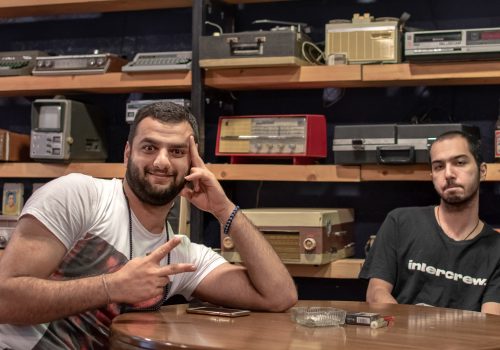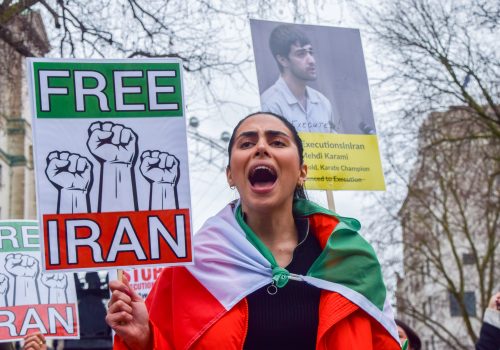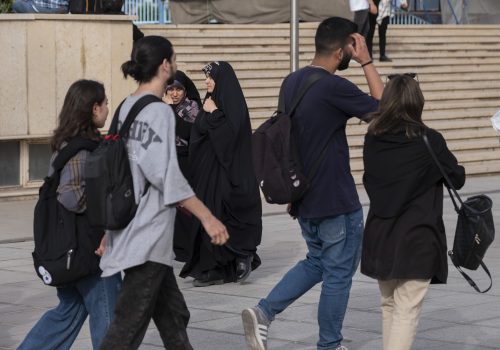Iran is socially engineering mass depression to suppress dissent
Not often does a seventy-year-old start a global social media phenomenon for his singing and dancing, but that’s precisely what has happened in the Islamic Republic of Iran, of all places.
Meet Sadegh Booghi—or “Amoo Booghi” (Uncle Booghi) as he has come to be known—an elderly fishmonger from a small northern Iranian town, who was detained by authorities after videos of him singing and dancing went viral on Instagram—the most popular social media platform in Iran and one that also happens to be blocked (Iranians use circumvention tools to bypass censorship). The pensioner’s Instagram page was suspended. It was reactivated after mass pressure, although a case against Booghi is still open.
What was Booghi’s crime? Spreading joy across the country—and much of the world.
As Amoo Booghi’s singing and dancing went viral—from Tanzania to Thailand—the key question on everyone’s mind is: why is the regime punishing an old man for spreading happiness at a time when the situation inside Iran is so dire? Surely it would make more sense for the clerical establishment to alleviate pressure on the population, rather than double down?
On the surface, the obvious answer to this relates to the regime’s ideology. The hardline Islamist worldview of the Islamic Republic, and its small but powerful constituency, subscribes to outlawing public dancing and singing as “un-Islamic” practices. In recent years, there’s no doubt that the regime has become more ideological and extremist—all of which is based on Supreme Leader Ayatollah Ali Khamenei’s forty-year manifesto aimed at “purifying” what he calls the “holy system” (nezam-e moghadas).
But while ideology is undoubtedly the underlying foundation of Booghi’s practices being deemed “un-Islamic,” the regime’s response is far from a knee-jerk ideological reaction—something all observers have so far overlooked.
For forty-five years, the clerical regime in Iran has worked tirelessly to achieve totalitarian status, combining its hardline Islamist zeal with its doctrines of suppression to control every aspect of the Iranian population. The Shia Islamists in Iran deem this necessary to achieve their ideological utopia and facilitate the return of the messianic so-called Hidden Imam, Mahdi.
To attain this utopia, the regime has worked tirelessly to strategize and doctrinize control of Iranians’ minds and bodies. The former relates to the regime’s systematic effort to radicalize the masses to exert control over their minds, while the latter refers to its efforts to physically—and often violently—enforce an ideological order on the Iranian people, enabling control over their bodies. The murder of twenty-two-year-old girl Mahsa Jina Amini by the so-called “morality police” for violating mandatory hijab rules, and the regime’s subsequent religious justifications were propagandized for her killing, best exemplifies this approach.
SIGN UP FOR THE THIS WEEK IN THE MIDEAST NEWSLETTER
This approach, however, has had an effect opposite of the regime’s goals; it has secularized and liberalized the Iranian people en masse. The more the regime has pushed, the more the gap between the state and society has increased, resulting in greater and more extreme suppression.
Based on the Islamic Republic’s calculations, the threat from within—namely, a popular revolution—is far greater than outside threats.
Much of this is unsurprising.
However, while there has been a lot of global and domestic attention on the suppression of bodies and minds, another aspect of the regime’s efforts to control Iranian society has been completely overlooked: its manipulation of emotions. Emotion manipulation refers to the state’s concerted efforts to engineer the masses’ emotions to incapacitate potential upheaval or uprising, and to maintain the political status quo.
Engineering control over the population’s emotions by the state is certainly not unique to the clerical establishment in Iran. The “politics of hate,” whereby political elites nurture emotional hatred toward inside or outside social groups as a means to exert political control, is a prime example. Another example—prevalent across authoritarian regimes—is the so-called “glue of fear,” in which dictatorial systems invoke emotional fear in the masses to preserve their status quo power.
In the context of Iran, however, the regime has sought to engineer another form of emotional manipulation over the Iranian population—namely, manufacturing mass psychological depression and hopelessness, otherwise known as the “politics of sadness and grief” (siasat-e gham-o ghoseh). The “politics of sadness and grief” refers to the regime’s strategized and coordinated efforts to depress the Iranian population to invoke mass hopelessness and despair and, thereby, psychologically paralyze belief in change. Through this strategy, the Islamic Republic has promoted gloom and hopelessness to the extent that citizens become paralyzed and incapable of challenging the political status quo. The result has simultaneously satisfied the Islamist and religious parts of society and suppressed its more progressive social spheres.
The idea that the regime has “taken hope away from us” (omid ra az ma gerftan) has become ubiquitous across every corner of the Iranian streets and the data support this. In 2022, the World Happiness Index ranked Iran the 110th-happiest country out of 156 in the world. In other words, Iran is the forty-fourth unhappiest place in the world. The country has also consistently experienced high levels of brain drain, with a 2019 study placing it among the nations with the highest levels of brain drain. This year, a medical report conducted inside Iran revealed that one out of every five medical prescriptions in Iran is for antidepressants. The surge in recreational drugs—especially among Iranian youth—is also directly correlated to mass depression and hopelessness within Iranian society.
While sociologists have sought to portray depression and sadness as features of Iranian and Shia identity, they have overlooked the concerted regime strategy to deliberately engineer this state of depression as a suppression mechanism.
The regime’s Shia Islamist ideology, of course, provides the perfect foundation and infrastructure to enable this suppression doctrine. The founder of the Islamic Republic, the late Ayatollah Ruhollah Khomeini, always insisted that fun had no place in Islam and that “we are the nation of political crying”—placing great emphasis on the necessity of mourning (azadari) to preserve the Islamic Revolution. His successor, Ayatollah Ali Khamenei—who has had to rely on suppression to maintain authority—has only doubled down on this notion.
The exponential growth in the number of official state-enforced Shia mourning and self-flagellation processions, as well as state resources to facilitate them, is one mechanism to precisely engineer the society’s emotions and invoke a consistent politics of sadness and grief. While Shia mourning processions took place before the 1979 Islamic Revolution, they were limited to a few days in Muharram for the martyrdom of Imam Hussain, one of the Shia saints killed in the Battle of Karbala in 680. In the past four decades, however, the regime has continuously expanded the number and frequency of enforced mourning ceremonies, de facto covering all twelve Shia imams, their offspring, and key regime figures—from Khomeini to assassinated Quds Force commander Qasem Soleimani. What is particularly noteworthy is the Islamic Republic’s decision to replace the celebration of the birthday of Imam Reza—the eighth Shia saint—as a national holiday with one that marks his martyrdom and death. Another example is commemorating the death of Fatimeh, the daughter of the Prophet Mohammad. Before the 2000s, Fatimeh’s death was not publicly commemorated, but it was later added to the national calendar and the mourning period was extended to two ten-day periods. Along with national mourning ceremonies, many weekly mourning recitations are held across schools, universities, and government-sector offices.
Another means through which the regime has sought to manipulate the emotions of Iranians and psychologically depress Iranian society is through manufacturing the appearance of public spaces in towns and cities across the country. Covering city walls with murals of “martyrs,” the regime has sought to remove color from public spaces and instead darken them with mourning. In Tehran, for example, the city council announced it had erected more than 11,000 black flags and inscriptions across the city.
In recent years, Khamenei has also significantly expanded the presence and authority of heyats, radical pro-regime Shia eulogy centers, all of which are connected to the Islamic Revolutionary Guard Corps (IRGC) and its Basij paramilitary. Whereas mosques are multipurpose in their use, heyats have one purpose: manipulating emotions through pro-regime eulogies and self-flagellation sessions, akin to a form of group radicalization.
Unlike clerics, the eulogists (maddahs) who lead the heyats are not required to have any seminary qualifications, and are usually selected due to charisma, ability to radicalize, and, most importantly, connections to the regime. Since 2009, Khamenei has rapidly expanded and consolidated the heyati network, which makes up Khamenei’s most radical and extremist support base. The latest statistics indicate that there are almost two hundred thousand maddahs. The apocalyptic doctrine of Mahdism—a Shia belief—is the most important pillar of the heyati culture, meaning their worldview heavily fetishizes death, the apocalypse, and the end of times. In other words, exporting doom and gloom across society is at the crux of this cult-like group.
In its attempts to manufacture a state of depression, the Islamic Republic has also sought to outlaw happy festivals and events in Iran. The regime has denounced Chaharshanbe Suri (the festival of fire) and Shabeh Yalda (winter solstice), two ancient Zoroastrian festivals that have historically involved jubilant celebrations. Other international and universal festivals of joy, such as Valentine’s Day, have been outlawed, with costly penalties for those indulging in the celebration of love. It should be noted, however, that the Iranian people have only doubled down in celebrating non-Islamic, secular, and Iranian festivals in defiance of the regime.
The targeting of Sadegh Booghi—and viral music before him, such as Pharell Williams’ “Happy”—is a product of the regime’s precise manipulation of the emotions doctrine. However, it has had the opposite effect of that desired by the regime, as evidenced by the wave of videos inspired by the singing and dancing, with happiness and joy emerging as an act of resistance against the regime. This follows a continuous forty-five-year trend in Iran, whereby the more the regime has sought to control its people—their minds, bodies, and emotions—the more it pushes people away. There’s a spirit of resistance against the Islamic Republic that remains very much alive more than a year after the Mahsa Amini anti-regime protests. Will light prevail over darkness? The history of Iran suggests so—and this could be enough to sustain hope and overturn the regime’s manipulation of emotions.
Saeid Golkar is a senior adviser at United Against Nuclear Iran and UC Foundation associate professor in the department of political science at the University of Tennessee at Chattanooga.
Kasra Aarabi is the director of IRGC research at United Against Nuclear Iran and a nonresident scholar at the Middle East Institute. Follow him on X: @KasraAarabi.
Further reading
Fri, Jun 26, 2020
Just how happy are Iranians with their lives?
IranSource By
Iran ranks 118 out of 153 countries on the UN’s 2020 World Happiness Index (WHI), slightly above the lowest quintile—the least happy.
Thu, Feb 9, 2023
Forty-four years of an Islamic Republic. Many now regret the 1979 revolution.
IranSource By
While there are disagreements over many aspects of the 1979 revolution, most Iranians agree that the country is in a far worse situation because of it.
Fri, Sep 8, 2023
Iran will never go back to the way it was
IranSource By Holly Dagres
While some argue that the ongoing anti-establishment protests began in mid-September 2022, the reality is that Iranians have been defying the regime for years.
Image: Iranian youths are walking past Valentine's Day gifts displayed on a sidewalk in downtown Tehran at night on February 13, 2024. (Photo by Morteza Nikoubazl/NurPhoto)


